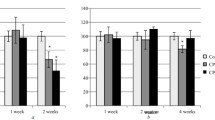Abstract
In order to explore the role of phospholipase A2 inhibition in the mechanisms of the action of glucocorticoids, it was investigated whether the steroid exhibits the analgesic and antipyretic actions as well as cyclo-oxygenase inhibitors such as indomethacin or not. Dexamethasone has been reported to produce the anti-inflammatory action with a lag time of at least 1 h at doses of up to 0.1 mg/kg in mice and rats. However, dexamethasone when given 4 h beforehand had no significant analgesic, activity even at doses of 1 and 10 mg/kg i.v. in the acetic acid writhing test in rats. In mice, the significant reduction in writhes counts was seen when dexamethasone (1 and 10 mg/kg i.v.) was given 15 min or 4 h before phenylquinone injection; i.e. the activity had not the lag time. On the other hand, dexamethasone showed a strong antipyretic activity against both the fevers caused by LPS and yeast in rats. In the yeast-febrile rats, the antipyretic activity had a lag time of about 1 h, and was dose-related at doses as low as 0.03 to 0.3 mg/kg i.v.; the steriod markedly reduced the increased PGE2 content in the cerebrospinal fluid. The antipyretic activity after local injection into the cerebroventricle or the yeast pouch was stronger than that after systemic injection into the tail vein, although so large a difference in the activity between the dosage routes was not seen, suggesting that the site of the antipyretic action is in both the brain and periphery. The antipyretic activity of dexamethasone (10 mg/kg i.v.) was not seen in rabbits with fever caused by LPS. These results suggest that dexamethasone failed to produce the clear analgesic and antipyretic actions. The relation of the present result to the phospholipase A2 inhibition by the steroid was discussed.
Similar content being viewed by others
References
R.J. Flower andJ.R. Vane, Some pharmacologic and biochemical aspects of prostaglandin biosynthesis and its inhibition. InProstaglandin Synthetase Inhibitors, pp. 9–18 (EdsH.J. Robinson andJ.R. Vane). Raven Press, New York 1974.
S. Moncada, S.H. Ferreira andJ.R. Vane, Pain and inflammatory mediators. InInflammation, pp. 588–616 (EdsJ.R. Vane andS.H. Ferreira). Springer-Verlag, Berlin, Heidelberg, New York 1978.
W.G. Clark,Mechanism of antipyretic action, Gen. Pharmac.10, 71–77 (1979).
G.J. Blackwell andR.J. Flower,Glucocorticoids, lungs and prostaglandins, Bull. europ. Physiopath. resp.17, 595–607 (1981).
F. Hirata, E. Schiffmann, K. Venkatasubramanian, D. Salomon andJ. Axelrod,A phospholipase A 2 inhibitory protein in rabbit neutrophils induced by glucocorticoids, Proc. natn. Acad. Sci. USA77, 2533–2536 (1980).
A. Danon andG. Assouline,Inhibition of prostaglandin biosynthesis by corticosteroids requires RNA and protein synthesis, Nature, Lond.273, 552–554 (1978).
F. Kantrowitz, D.R. Robinson andM.B. McGuire,Corticosteroids inhibit prostaglandin production by rheumatoid synovia, Nature, Lond.258, 737–739 (1975)
C.J.E. Niemegeers, J.A.A. Van Bruggen andP.A.J. Janssen,Suprofen, a potent antagonist, of acetic acid writhing in rats, Arzneimittel-Forsch.25, 1505–1509 (1975).
H. Nakamura, Y. Yokoyama, S. Motoyoshi, K. Ishi, C. Imazu, Y. Seto, T. Kadokawa andM. Shimizu,The pharmacological profile of 2-(8-methyl-10,11-dihydro-11-oxodibenz[b,f]oxepin-2-yl)-propionic acid (AD-1590), a new non-steroidal anti-inflammatory agent with potent antipyretic activity, Arzneimittel-Forsch.33, 1555–1569 (1983).
H. Nakamura andM. Shimizu,Comparative study of 1-cyclohexyl-4-(1,2-diphenylethyl)-piperazine and its enantiomorphs on analgesic and other pharmacological activities in experimental animals, Archs int. Pharmacodyn. Thér.221, 105–121 (1976).
H. Nakamura, Y. Yokoyama, Y. Seto, T. Kadokawa andM. Shimizu,AD-1590, a potent antagonist of lipopolysaccharide-induced fever in rabbits, J. Pharm. Pharmac.33, 182–186 (1983).
M.K. Church andP. Miller,Time courses of the anti-anaphylactic and anti-inflammatory effects of dexamethasone in the rat and mouse, Br. J. Pharmac.62, 481–486 (1978).
S. Tsurufuji, K. Sugio andF. Takemasa,The role of the glucocorticoid receptor and gene expression in the anti-inflammatory action of dexamethasone. Nature, Lond.280, 408–410 (1979).
S. Tsurufuji, K. Sugio, F. Takemasa andS. Yoshizawa,Blockade by antiglucocorticoids, actinomycin D and cycloheximide of anti-inflammatory action of dexamethasone against bradykinin, J. Pharmac. exp. Ther.212, 225–231 (1980).
D.R. Robinson, D.P. Curran andP.J. Hamer,Prostaglandins and related compounds in inflammatory rheumatic diseases Adv. Inflamm. Res.3, 17–27 (1982).
P.K. Bondy andP. Bodel, Mechanism of action of pyrogenic and antipyretic steroidsin vitro. InPyrogens and Fever, pp. 101–113 (EdsG.E.W. Walstenholme andJ. Birch). Churchill Livingstone, London 1971.
E. Atkins, F. Allison, M.R. Smith andW.B. Wood,Studies on the antipyretic action of cortisone in pyrogen-induced fever, J. exp. Med.101, 353–366 (1955).
I.L. Bannett andP.B. Beeson,The effect of cortisone upon reactions of rabbits to bacterial endotoxins with particular reference to aquired resistance, Bull. Johns Hopkins Hosp.93, 290–308 (1953).
G.H. Willies andC.J. Woolf,The site of action of corticosteroid antipyresis in the rabbit, J. Physiol., Lond.300, 1–6 (1980).
I. Chowers, N. Conforti andS. Feldmann,Local effect of cortisol in the preoptic area on temperature regulation, Am. J. Physiol.214, 538–542 (1968).
G. Giannopoulos, Z. Hassan andS. Solomon,Glucocorticoid receptors in fetal and adult rabbit tissues, J. biol. Chem.249, 2424–2427 (1974).
M.N. Alexis, F. Stylianopoulou, E. Kitraki andC.E. Sekeris,The distribution and properties of the glucocorticoid receptor from rat brain and pituitary, J. biol. Chem.258, 4710–4714 (1983).
Z.Y. Yu, Ö Wrange, J. Boethius, J.Å. Gustafsson andL. Granholm,A qualitative comparison of the glucocorticoid receptor in cytosol from human brain and rat brain, Brain Res., Osaka223, 325–333 (1981).
L. Angelucci, P. Valeri, M. Palmery, F.R. Patacchioli andA. Catalani,Brain glucocorticoid receptor: correlation of in vivo uptake of corticosterone with behavioral, endocrine, and neuropharmacological events, Adv. Biochem. Psychopharmac.21, 391–406 (1980).
R.J. Gryglewski, Screening and assessment of the potency of anti-inflammatory drugsin vitro. InAnti-inflammatory Drugs, pp. 3–43 (Eds.J.R. Vane andS.R. Ferreira). Springer-Verlag, Berlin, Heidelberg, New York 1979.
A. Dembińska-Kieć, A. Źmuda andJ. Krupińska,Inhibition of prostaglandin synthetase by aspirin-like drugs in different microsomal preparations Adv. Prostaglandin Thromb. Res.1, 99–103 (1976).
Author information
Authors and Affiliations
Rights and permissions
About this article
Cite this article
Nakamura, H., Mizushima, Y., Seto, Y. et al. Dexamethasone fails to produce antipyretic and analgesic actions in experimental animals. Agents and Actions 16, 542–547 (1985). https://doi.org/10.1007/BF01983660
Received:
Accepted:
Issue Date:
DOI: https://doi.org/10.1007/BF01983660




